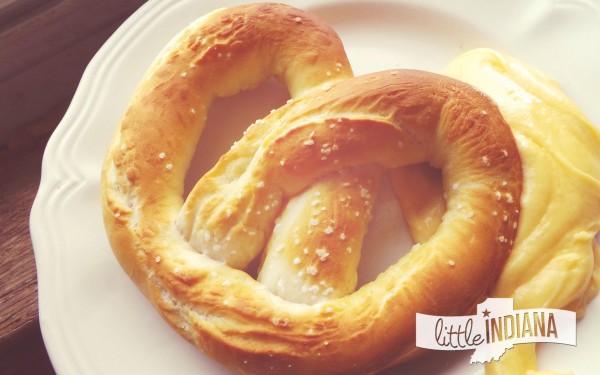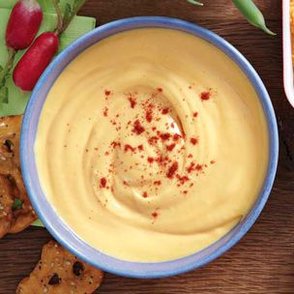
When I received this Spicy Mustard and Cheese Dip recipe from Colman’s, I held onto it, intending to read it off to our 10 year old as a potential snack idea. He thought it sounded good–and like something we should make right away. It hit me that it would make the perfect pairing with my world famous homemade pretzels! He couldn’t have agreed more.
So, we got busy. The youngest, age 6, wanted to help too. We made the pretzel dough and they shaped it into knots and balls. They’ve had experience making pretzels at home before–and at the Tell City Pretzel Company, too. Yes, we love our pretzels.
After the dough rose, I popped the pretzels into the preheated oven, and made the dip.
The timing was perfect. We could barely wait a minute for the pretzels to cool! Crispy on the outside, soft on the inside, and dipped in a cheesy, mustardy dip–yeah, we had to make more pretzels for the dip the very next day!
Colman’s Spicy Mustard and Cheese Dip

This dip is so simple to make. What you will do is begin by making a roux. Julia would be proud, right? It’s a supremely simple and easy to fix sauce.
You can have this recipe done in ten minutes or less. No kidding. It’s just that easy! Of course, homemade pretzels are going to take a bit longer–but you could always use store-bought pretzels or other favorite dippers.
I love to bring out dips when I am entertaining or when I need something to bring to a pitch-in or cookout. Everyone loves dips. Who wants to fuss around in the kitchen when there is fun to be had?
History of Mustard

Mustard is a wild plant. The hard seeds of the plant are crushed or ground and mixed with seasoning to create that popular yellow condiment.
The Nibble shares that food historians believe that mustard was cultivated 3,000 years ago BCE in India though it wouldn’t be until the 1300s that mustard would actually be termed “mustard.”
The Greeks and Romans used mustard as a condiment and as a medicine. French monasteries began selling mustard in the 9th century. The Nibble states, “Mustard-making was so important that in 1634, a law was passed to grant the men of the town [Dijon] the exclusive right to make mustard.”
Around the world, more than 700 million pounds of mustard are consumed each year, according to Minnesota and Wisconsin Extension Services. They share that the French eat the most–about 1.5 pounds a person each year.
In the US, 250,000 acres contain mustard crops. Can you guess which state grows the most mustard? North Dakota is the country’s top producer of the mustard plant.
Mustard Fans Unite

I have always been a huge mustard fan. When I was in elementary school, we used to get these triangular-shaped hash browns with our “hot lunches.” I put mustard on mine. One day, one of the lunch ladies noticed (Alice, for those of you who were with me) and called over the other lunch lady! They were chuckling about it. Do you know what? It’s still what I would do today–just ask my hot dog. There’s no ketchup there!
It turns out: I’m not alone in my love for mustard. Have you ever heard or used the term “cut the mustard?” Do you know what it means? It’s a phrase that’s included in an O. Henry book from 1903. It had to have been a part of popular terminology of the day. Yes, mustard was set as the high quality to meet or exceed. So, if someone “cut the mustard,” it means that s/he at least met expectations–if not surpassed.
Why, there’s even a National Mustard Day and a Mustard museum. The National Mustard Museum began in 1986 and has since grown and expanded to more than 5600 jars of mustard on display–and hundreds of mustard-related items to look at too. You can find the National Mustard Museum in Middleton, Wisconsin. I’m going to guess the big museum has a jar or two of Colman’s!
Colman’s Mustard: A Brief History
When I think of mustard, there’s only one brand that comes to mind: Colman’s Mustard. In 1814, Jeremiah Colman began a mustard and flour business. It was located in Stoke Holy Cross, four miles away from Norwich. Jeremiah Colman’s great-nephew Jeremiah James Colman based the production factory in Norwich in 1858–which is exactly where you will find it today!
Now that’s a lengthy history. In a time when factory workers weren’t always treated the best, it’s been said that Jeremiah James Colman was different, that he, according to Colman’s history, “cared deeply about family values.” He organized a school for employee’s kids, as well as providing company housing, and sick benefits.
Fast forward a couple hundred years, and the mustard-making process is very similar. They use the 1890s seed drier building that’s equipped with 1950s equipment. They are able to source 60% of the mustard seeds locally. How neat is that? They pride themselves on using local produce as much as possible. If only every company behaved that way!
In fact, Colman’s website reveals that “all of our mint, apples and white mustard are sourced in the UK and we are increasing the amount of locally sourced brown mustard. In addition to this, we also mill all our mustard seeds on site.” Do you know what I see? Plenty of local jobs.
Since 2012, you can count them among the green companies as well–100% of the UK mint and mustard are “green.” They have been sourced using sustainable practices.
Changes at Colman’s

Things have certainly changed in some ways. They still offer their famous dry mustard, (deviled eggs wouldn’t be “mom’s” deviled eggs without it!) but Colman’s product line has expanded. You’ll find jars of different mustards, from original to mild to whole grain, to sauces, other condiments (like horseradish! Mmm!), and various meal kits.
Browse Colman’s recipes to get out of that recipe rut! While you are at it, you might just find plenty of recipes here on Little Indiana that will get you back in the kitchen and loving it.
Colman’s happens to be one of the oldest food labels. After knowing a bit of their history, it comes as no surprise. Enjoy the big game this weekend–but keep this recipe for Colman’s Spicy Mustard and Cheese Dip handy. You’ll make it for company (and the family) again and again!
Ingredients
- 2 Tablespoons Butter
- 2 Tablespoons Flour
- 1 Cup Milk
- 1 ½ Cups Sharp Cheddar Cheese
- 2 Tablespoons Colman's Prepared Mustard
Instructions
- Melt Butter in a saucepan over medium heat.
- Slowly whisk in Flour to Melted Butter. Whisk until smooth.
- Let cook until mixture thickens (approximate 2-3 minutes).
- Carefully add Milk into Butter mixture. Stir with wooden spoon to mix.
- Cook and stir until mixture thickens, approximately 3 minutes.
- Add Cheddar Cheese and stir until the cheese is melted.
- Season with Salt and Colman's Prepared Mustard.
- Serve warm with your favorite dippers!
Little Indiana was provided with a sample of Colman’s Mustard in exchange for a truthful, honest review. Her opinions are hers alone and do not reflect Colman’s Mustard, etc.
Small Towns: Destinations, not Drive-Thrus! I’m Jessica Nunemaker and THIS is Little Indiana.
Just don’t forget to tell them that Little Indiana sent you.
Targeted. Relevant. Affordable! Little Indiana advertising.